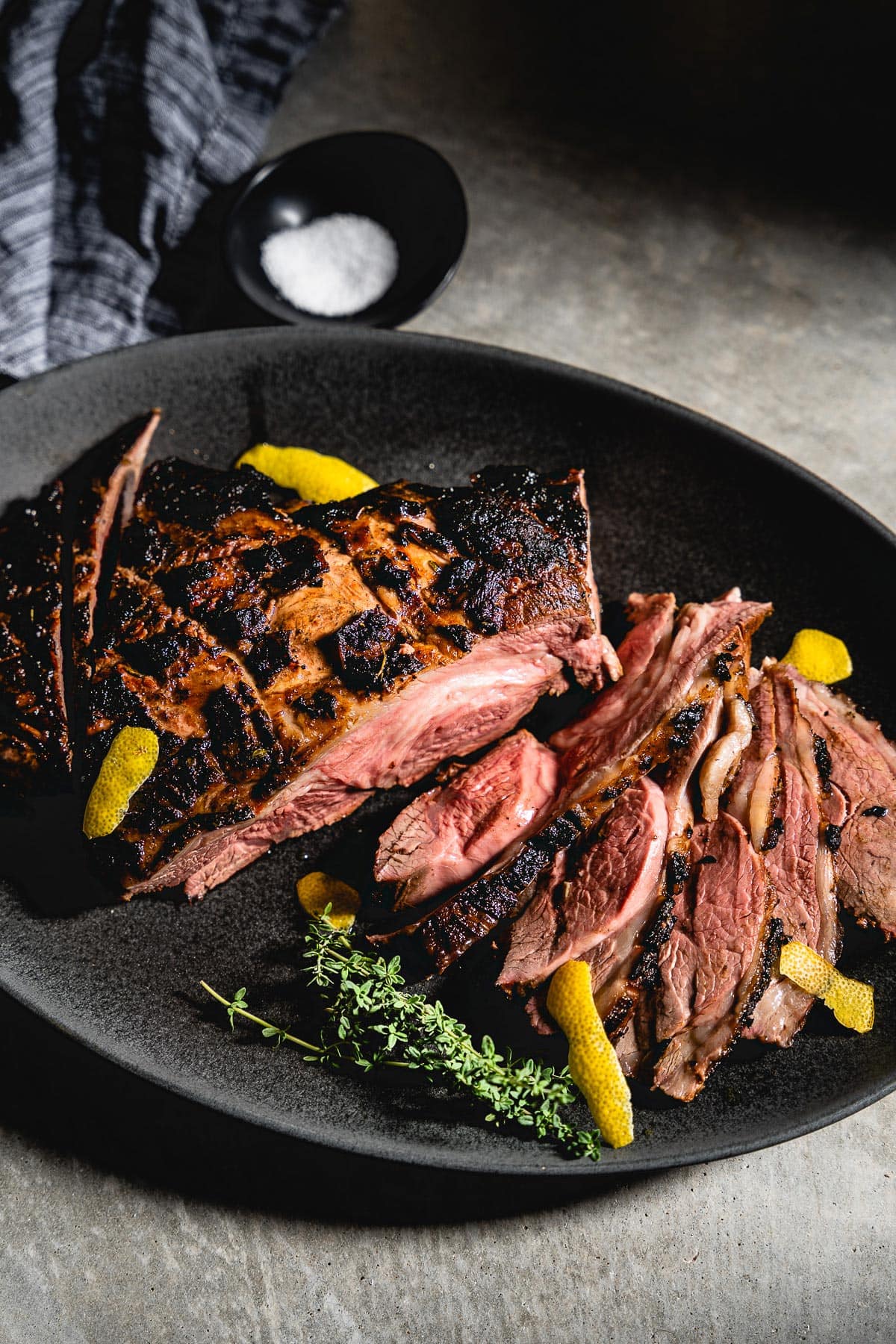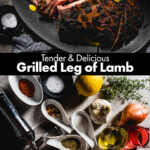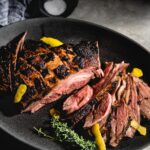This recipe was created in partnership with the American Lamb Board. All thoughts and opinions are always my own.
Leg of lamb, butterflied and marinated with the perfect blend of tastes and aromas before hitting the grill, is so delicious. Melt-in-your-mouth tender and full of smoky lamb flavor.
There are numerous ways to cook a leg of lamb. While the most popular is probably roasting, taking it outside to the grill is a worthwhile trip because of the additional smoke flavor. And butterflying it will make it cook much faster than a traditional roast.
The goal is to develop a flavorful crust while perfectly cooking the interior from edge to edge. To achieve this, we utilize a two-zone cooking method with a hot side and a cooler side on the grill. We sear the butterflied boneless leg of lamb on the hot side of the grill, then move it to the cooler side to finish cooking (much like searing a steak on a hot stove, then moving it to the oven to finish). Learn more in the lamb grilling guide.
The American lamb is the star here: Elevated by an herby and complex marinade, it takes on that luscious smoky flavor from the grill. It pairs perfectly with grilled veggies you can make right alongside the lamb. And we can’t stop eating the leftovers; they are even wonderful cold in sandwiches on salads and crisped up on top of lamb tostadas.
Why You’ll Love Grilling a Butterflied Leg of Lamb
While it’s definitely possible to cook a bone-in leg of lamb on the grill, it can take a while, and there is less surface area for the marinade to come into contact with. I prefer to go boneless and butterflied because of how quickly it cooks and how much flavor you can get on the outside, with all that extra surface area.
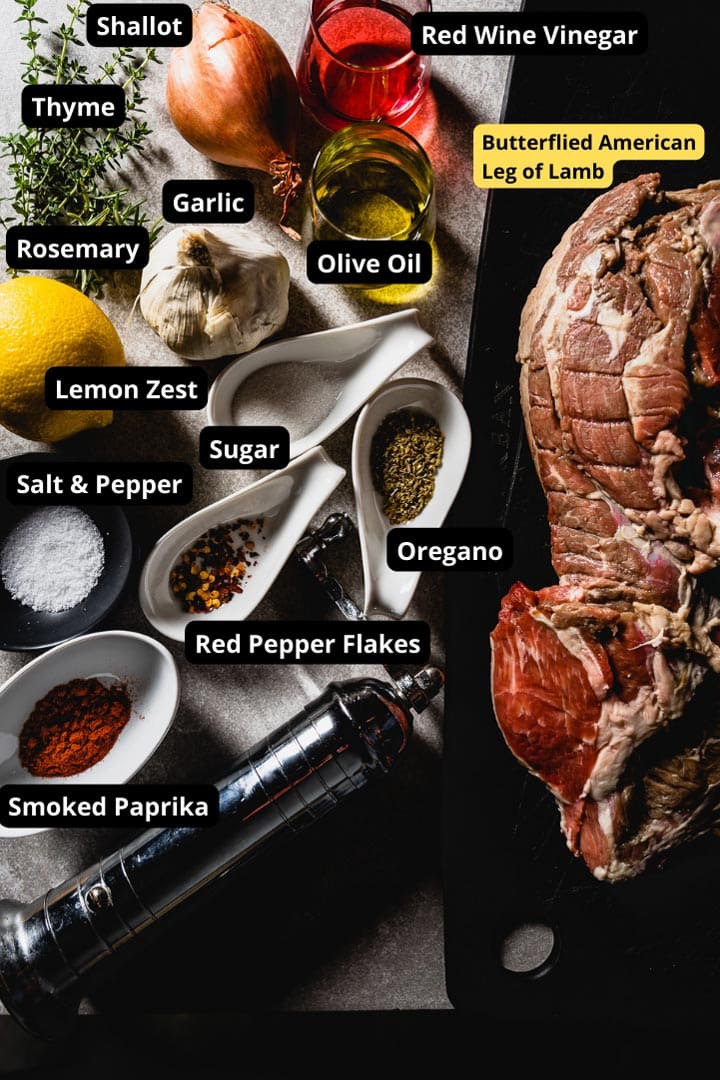
Ingredients You’ll Need
- Boneless American Lamb Leg, butterflied – Domestic American lamb is generally larger, milder and sweeter tasting than imported lamb thanks to a diet of grass and finished with grain. It also didn’t have to travel thousands of miles to get here.
Your local butcher is usually the best place to source it. A butterflied leg will cook evenly and more quickly on the grill.
If it’s boneless, more likely than not it is already butterflied, which is how they removed the bone in the first place. Sometimes the “corkscrew” method is used to remove the bone. Your butcher can usually butterfly it for you if it isn’t already. And if they only have bone-in, they can help you with that as well.
A whole boneless lamb leg is usually around 5 to 8 pounds and a half boneless leg is usually 3 to 4 pounds. - Kosher Salt – The seasoning that will bring out all of the flavor. Use 1 teaspoon Diamond kosher salt (or ¾ teaspoon Morton kosher salt) per pound of lamb. Remember to salt at least 12 hours in advance if possible, and preferably 24 hours.
- The Marinade – An herby balance with some aromatics and acidity includes shallot, garlic, lemon zest, fresh thyme, rosemary, oregano, smoked paprika, sugar, red wine vinegar, olive oil, black pepper and some red pepper flakes if you want a bit of extra heat. Feel free to play with the marinade with whatever you have in your pantry to make it your own.
See the recipe card for quantities.
Tools & Equipment Used
- Sharp Boning Knife to trim excess fat and butterfly the lamb leg if needed.
- Grill – I prefer a charcoal grill, but any grill with a lid will work.
- Meat Pounder for evening out the thickness of the lamb leg so it cooks evenly.
- Long Tongs for working the grill.
- Remote Probe Thermometer Alarm for remotely monitoring the internal temp of the lamb and the grill.
- Instant-Read Probe Thermometer to verify doneness.
- Long Slicing Knife for slicing the cooked lamb into thin slices. I love this Granton blade knife for the task.
How to Grill Leg of Lamb
Step-by-step for how to prep, season and grill a boneless leg of lamb.
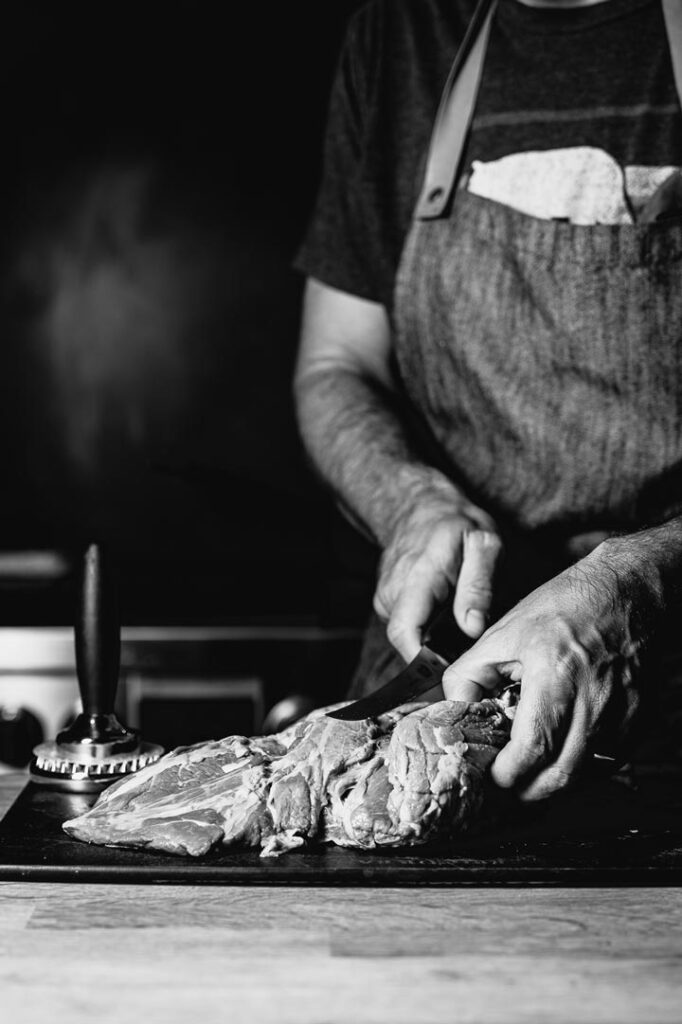

- Prep the Butterflied Lamb Leg: Trim off excess fat, silver skin and any loose pieces that could burn on the grill. Score the fat cap into a crosshatch pattern, which will help it get crispy and also allow the marinade to penetrate into the meat. Pound the leg with a meat pounder to even out any thick portions so it cooks evenly on the grill.

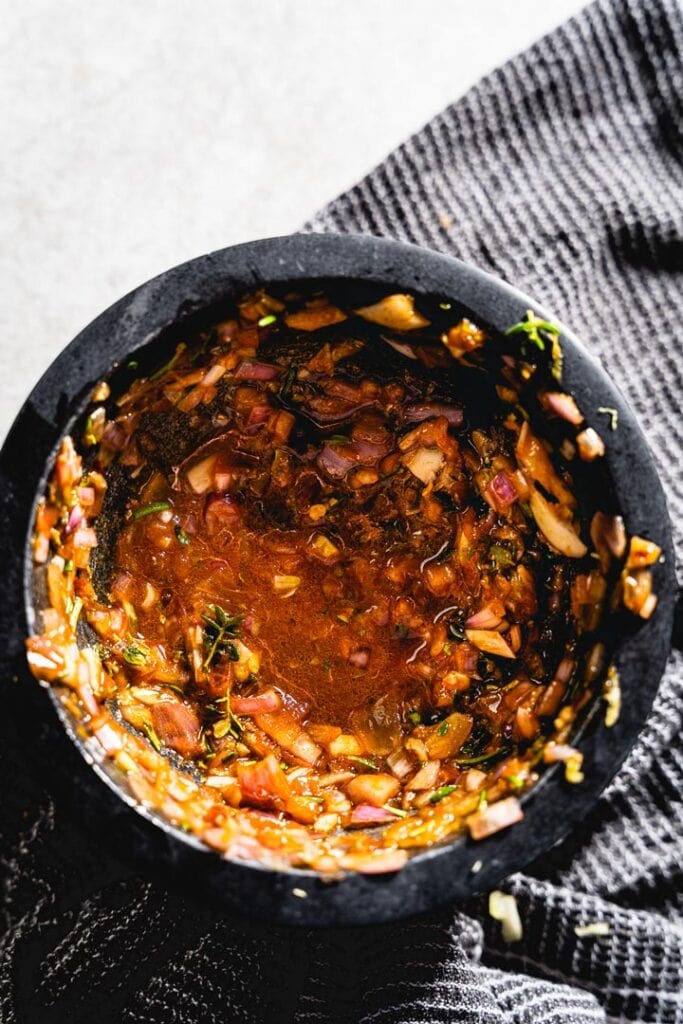
2. Make the marinade by combining all the marinade ingredients in a food processor or hand blender or by using a mortar and pestle. You can make it into a paste, but it’s totally fine if there is still a lot of texture.
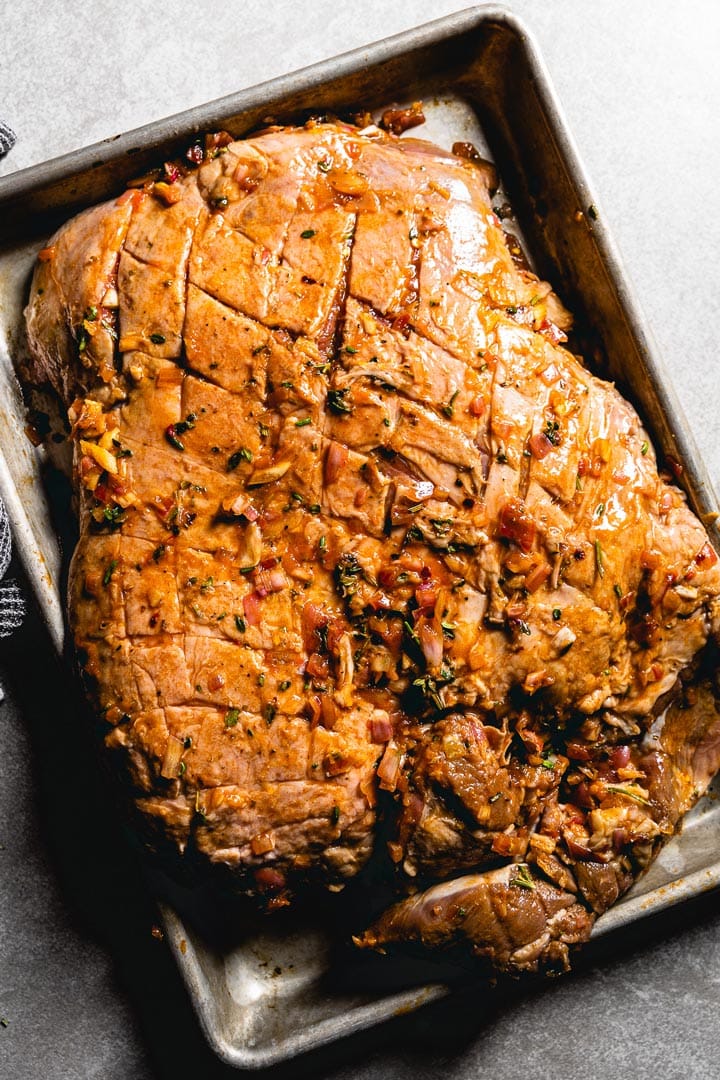
3. Season all sides very liberally with kosher salt and then apply the marinade. Cover and refrigerate for at least 12 hours and preferably 24 hours to allow the salt and marinade to work their magic.
4. Remove the lamb from the refrigerator to temper for about 30 minutes while you prep the grill.
5. Set up the grill for two-zone cooking and preheat to around 400° F. For a charcoal grill, add the coals to one side and for a gas grill light only half of the burners.
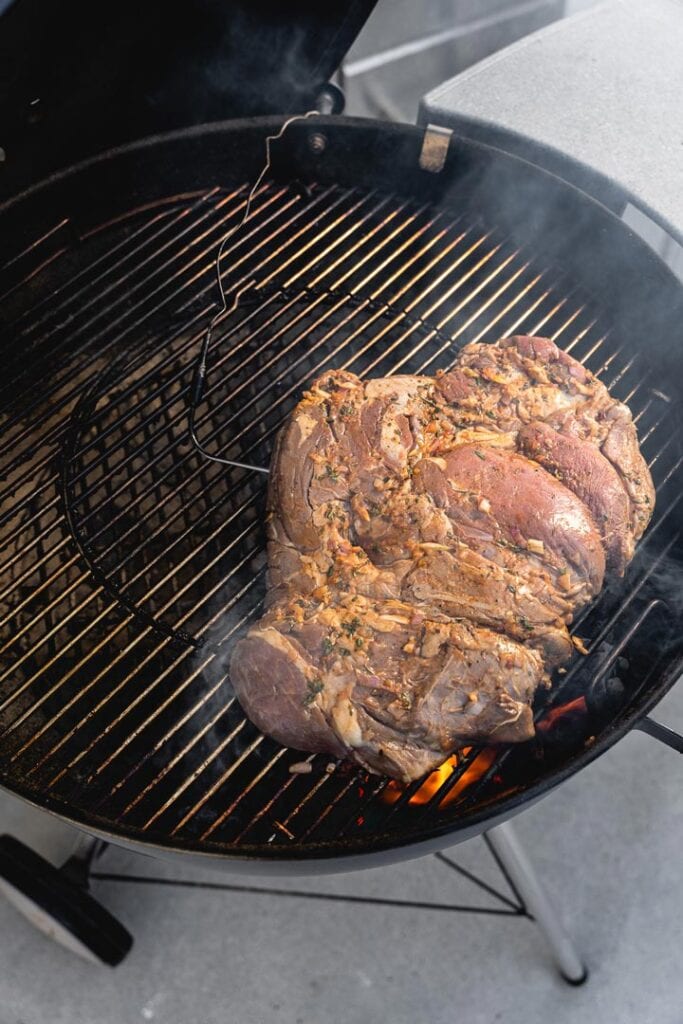
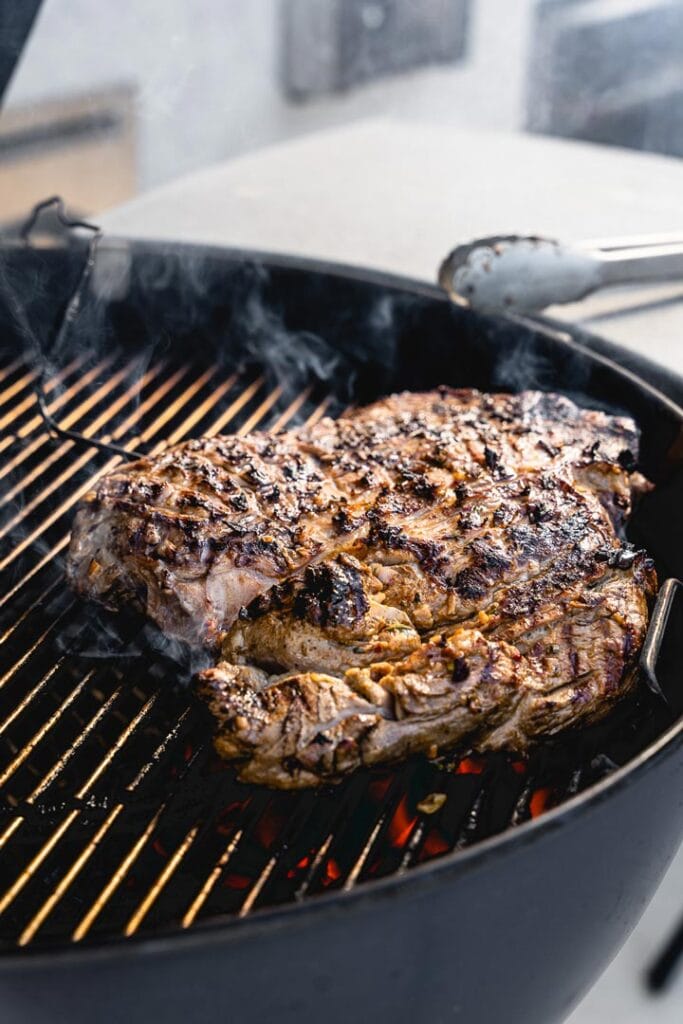
6. Sear the lamb leg on the hot side of the grill for about 4 minutes per side to develop a nice crust.
Tip: To help avoid flare-ups, sear with the lid closed. If you do get flare-ups, move the lamb to the cooler side of the grill.
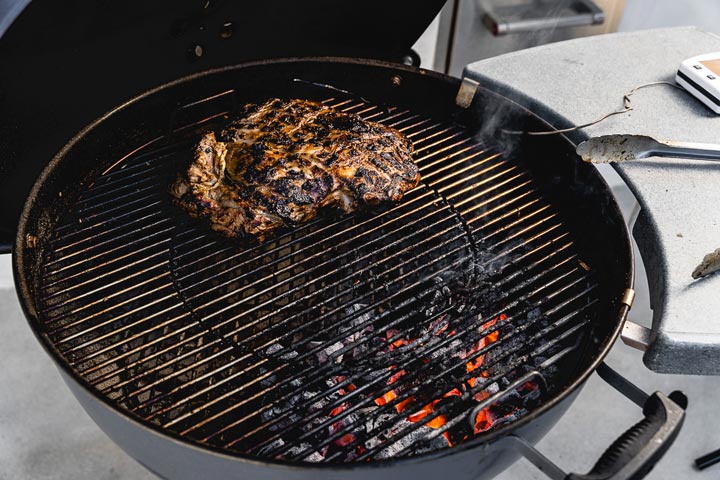
7. Move the leg over to the cooler side of the grill after searing both sides, close the lid and continue to cook until the desired internal temperature is reached (see chart below). A remote probe thermometer is essential for perfect results to know exactly when you should pull the lamb off the grill to rest.
8. Rest the lamb. Remove the leg from the grill to rest for 15 to 20 minutes.
9. Slice against the grain only as much as needed for serving to keep it juicy.
Target Temperatures & Resting
Grilling a large cut of meat at high heat creates carryover cooking, where the internal temperature continues to rise even after it’s removed from the grill. To account for this, we use a “pull temperature” – the temperature at which you take the lamb off the heat. During the resting period, the internal temperature will reach your desired final doneness (thanks to carryover cooking).
Always use an instant-read thermometer for accurate temperature readings.
| Doneness | Pull Temp (5 to 10 degrees before target temp) | Target Finished Temp (after resting ) |
| Medium-Rare | 125-130° F | 130-140° F |
| Medium | 130-135° F | 135-145° F |
| Medium-Well | 135-140° F | 140-150° F |
Boneless leg of lamb taking approximately 12 minutes per pound on the grill
Carving the Leg of Lamb
Carving a butterflied leg of lamb is quite simple. Always slice against the grain using a long, sharp knife. There are different parts of the leg that will have different grain directions, which are often easier to see before the lamb is grilled. And only carve what you need at the time to keep it juicy.
Tips for Success
- Salt Early: This large cut of meat needs time for the salt to penetrate. Season generously at least 12 hours in advance, preferably 24 hours.
- Lamb Flavor Control: The fat layer contributes significantly to lamb flavor. Leave it on for a more intense lamb taste, or trim more for a milder flavor.
- Cook by Temperature, Not Time: Don’t rely on timing alone. Use a thermometer to ensure safe and perfectly cooked lamb.
- Thermometer is Key: A reliable thermometer is essential for knowing exactly when to remove the lamb from the grill.
- Two-Zone Advantage: A two-zone grill setup gives you control over the cooking process. You can achieve even cooking throughout the roast while still getting a great sear.
- Taming Flare-Ups: Lamb fat can cause flare-ups as it drips onto the heat source. Trim excess fat beforehand. If flare-ups occur, move the lamb to the cooler side of the grill and close the lid until they subside.
- Mind the Carryover: To avoid overcooking, remove the lamb from the grill before it reaches the final desired temperature. The internal temperature will continue to rise 5-10 degrees after resting due to carryover cooking.
- Double Duty Lamb: This recipe makes a generous amount. If you’re not feeding a crowd, consider using half for this recipe and turning the rest into lamb kabobs!
Serving Suggestions
Leg of lamb is incredibly versatile. Serve it up with classic creamy sous vide polenta, add it to a salad, or put it in pita bread with hummus, spicy harissa aioli and heirloom tomatoes (my favorite). The ways to enjoy it are pretty much endless. One of my faves is to serve it with mint chimichurri or Italian salsa verde.
Grill some onions alongside, or with quick pickled onions, put it in pita with a touch of yogurt sauce. Make tacos with a simple pico de gallo, or sandwiches on brioche buns with arugula and a BBQ vinaigrette or some ginger-lime aioli. Goes great with grilled broccolini or grilled potatoes or even creamy mashed potatoes. It’s heaven with an heirloom tomato salad.
Wine pairing: Go with a hearty red, a Bourdeaux or even a Malbec. With the mint chimichurri or salsa verde, a crisp white, such as a sauvignon blanc or pinot grigio. For beer, a nice malty beer, like Karl Strauss Red Trolley, goes great. A Belgian blonde (e.g., Societe’s The Harlot) is perfect if you prefer a crisper option.
Storage & Reheating Instructions
- Refrigerate: Tightly wrap or place leftover lamb in an airtight container and store in the refrigerator for up to 3 days.
- Freeze: For longer storage, vacuum seal leftover lamb (recommended) or wrap tightly in multiple layers of plastic wrap and freeze for up to 6 months.
- To Reheat: For best results, reheat leftover lamb slowly over low heat on the stovetop, covered, with a splash of broth or water added to prevent drying. Alternatively, reheat in the oven at 300°F (150°C) tented with foil until warmed through.
More Delicious Lamb Recipes
If you love leg of lamb, be sure to check out the herb-crusted sous vide leg of lamb, grilled lamb burgers, smoked lamb shoulder, grilled lamb chops and smoked lamb tostadas.
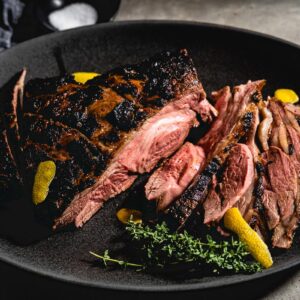
Grilled Leg of Lamb
Ingredients
- 3 to 5 lb butterflied boneless leg of American lamb
- 1 tsp Diamond kosher salt (or 3/4 tsp Morton kosher salt) per pound of lamb
Marinade
- 2 shallots, chopped
- 6 garlic cloves, chopped
- 2 tsp lemon zest
- 2 tsp fresh thyme, chopped
- 1 tsp fresh rosemary, chopped
- 1 tsp dried oregano
- 1 Tbsp smoked paprika
- 2 tsp sugar
- 2 Tbsp red wine vinegar
- Ground pepper
- Red pepper flakes optional
- Olive oil
Instructions
Prepare the lamb at least 12 hours ahead and up to 2 days in advance.
- Trim excess fat and remove silverskin using a sharp knife. Score the top layer of fat in a 1/2" crosshatch pattern, being careful not to slice into the flesh.
- Using a meat pounder, or the back of a heavy skillet, pound the butterflied lamb leg so it is relatively even.
- Season all sides very liberally with kosher salt.
- Make the marinade paste by blending all marinade ingredients together with an immersion blender or food processor or use a mortar and pestle.
- Spread the paste all over the lamb leg on a sheet pan. Cover tightly with plastic wrap and refrigerate for 12 hours or preferably 24 hours.
- Remove the lamb from the refrigerator to temper for about 30 minutes while you set up the grill. Insert a remote thermometer probe through the side of the thickest part of the meat.
- Prepare the grill with a two-zone setup and bring the temperature up to 400° F. Preheat and add wood chips for extra smoke if desired. Clean and oil the grill grates using a canola oil-soaked paper towel and tongs. /
- Sear the leg (fat side down first) on the hot side of the grill for about 4 minutes per side to get a flavorful golden crust, then transfer to the cooler side of the grill and close the lid.
- Continue to cook to an internal pull temperature of 125 to 130°F for medium-rare** (will finish at 130-140° F) or 130 to 135° F for medium (will finish at 135-145° F). This will be approximately 12 minutes per pound. Use an instant-read thermometer to verify doneness. The temperature will continue to rise 5 to 10 degrees after it is off the grill, so pull from the grill before it reaches the desired finished temperature.
- Transfer to a cutting board and rest for 15 to 20 minutes.
- Carve the lamb leg by slicing against the grain. Enjoy!
Notes
- **The USDA recommends a minimum internal temperature of 145 °F (62.8 °C) with a 3 minute rest.
- Carryover cooking: The lamb leg will continue to rise in temperature 5 to 10 degrees after it is off the grill, so remove it from the heat prior to the desired finished temperature.
- If you are experiencing flare-ups while searing, move the lamb to the cooler side of the grill and close the lid.
- Want it extra smoky? Add some apple or cherry wood chips to the fire.
- Figure 6 to 8 ounces of cooked lamb per person.

